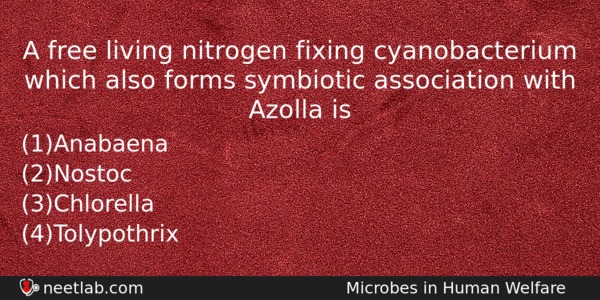| ⇦ | 
| ⇨ |
A free living nitrogen fixing cyanobacterium which also forms symbiotic association with Azolla is
Options
(a) Anabaena
(b) Nostoc
(c) Chlorella
(d) Tolypothrix
Correct Answer:
Anabaena
Explanation:
Anabaena azollae resides in the leaf cavities of the fern Anabaena. It fixes nitrogen. A part of the fixed nitrogen is excreted in the cavities and becomes available to the fern. The decaying fern plants release the same for utilization of the rice plants.
Anabaena is a genus of filamentous cyanobacteria that exist as plankton. They are known for nitrogen-fixing abilities, and they form symbiotic relationships with certain plants, such as the mosquito fern.
Related Questions: - Which of the following features is used to identify a male cockroach from
- Guttation is the release of liquid water from veins at leaf margins. It is caused by
- Biolistics (gene-gun) is suitable for
- Guttation occurs in
- Which of the above said statements are correct about Norepinephrine?
Topics: Microbes in Human Welfare
(63)
Subject: Biology
(4253)
Important MCQs Based on Medical Entrance Examinations To Improve Your NEET Score
- Which of the following features is used to identify a male cockroach from
- Guttation is the release of liquid water from veins at leaf margins. It is caused by
- Biolistics (gene-gun) is suitable for
- Guttation occurs in
- Which of the above said statements are correct about Norepinephrine?
Topics: Microbes in Human Welfare (63)
Subject: Biology (4253)
Important MCQs Based on Medical Entrance Examinations To Improve Your NEET Score
18000+ students are using NEETLab to improve their score. What about you?
Solve Previous Year MCQs, Mock Tests, Topicwise Practice Tests, Identify Weak Topics, Formula Flash cards and much more is available in NEETLab Android App to improve your NEET score.
Share this page with your friends

Leave a Reply